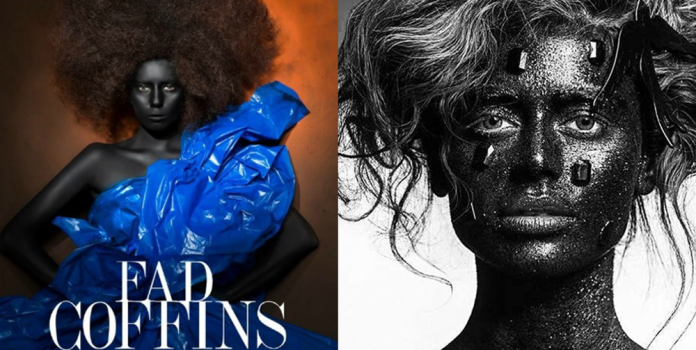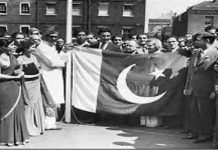Making pale faced models ‘dark skinned’ has become something of a trend in Pakistan, and it has always backfired. Why not pick a model with a deeper skin-tone instead? Because you’re relatively unlikely to find a dusky-skinned model.
Alee Hassan recently came out with a shoot named ‘Fad Coffins’ where he contrasted bright colours against a model’s skin painted black. He used plastic to create vibrant, high-fashion outfits but the supposed creativity of his work was lost on several people. This isn’t the first time an artist in Pakistan has been accused of racism.
The shoot received considerable backlash from various publications and the general public because it was deemed ‘racist,’ which is somewhat debatable. One on hand, people have been complaining about how everyone has become unusually sensitive and that all the hype surrounding this shoot is baseless, while on the other hand we have people accusing Alee of racism, and bashing him for ‘expressing his creativity.’ In all fairness, both sides are correct, in their own right.
Judging from the comments on his pictures, it is evident that a lot of people do not consider his shoot racist, because he is not demeaning black people in any way, which is true. In a conversation with Alee Hassan himself, he explained that his concept was not targeting a particular race, nor was he trying to portray anyone in an indignant light. When you first look at the shoot, yes, it does look quite a lot like ‘blackface’, however, it does not portray the negative connotations associated with it, and the model is not conveying racial stereotypes. He has been accused of using blackface in an attempt to profit off of the outrage and controversy, but judging from what he said regarding the use of the colour black (he likes to experiment with colours), it appears to be more of a lapse in judgement as opposed to malicious intent.
Although he’s made it clear that he’s not racist, and that he didn’t mean to offend anyone with his concept, I still feel like he could have executed it in a better way. His work speaks for itself, and it wouldn’t have been hard for him to find a black model.
When this scribe asked him why he used the colour black in particular? He said, “I liked to experiment with different hues.”
The writer rephrased the question in an attempt to gather more information when he directed the question towards other shoots that had painted models in black. Alee Hassan might not be a racist, however, there’s a very specific phrase for what he’s done; cultural appropriation. He did not use ‘blackface’ in an attempt to insult black people, but he did steal a bit of their culture. That is the only crime you can really accuse him of. In his defence, he likes exploring the human form and uses colours on the model’s bodies often, which seems fair enough, but I’m sure there are several other ways he could’ve done it. Cultural appropriation works both ways, we can’t accuse white people of stealing our culture when we’re appropriating African American culture ourselves.
This writer did some research and came across shoots that had used ‘blackface’, and Alee Hassan’s cultural appropriation paled in comparison. All he did was steal black skin and afro hair, but one of the shoots seemed problematically disturbing. Not only did they paint a male model black and put him in an odd pose, they also made him portray carnal desperation through his facial expressions as he’s clutching a paler woman against himself, which seems like a more genuine depiction of blackface to viewers. Another shoot features Sadaf Kanwal, painted black with a starved look on her face. It was hard to identifying these shoots because no one made noise on social media about them, although they were much more offensive than Alee’s cultural appropriation.
Some people are of the opinion that Pakistanis shouldn’t be the ones causing brouhaha regarding racism, because they did not play a part in oppressing black people, and while it may seem like a rational approach to some, there’s no denying that people of subcontinent were both victims of colonisation and racial discrimination at one point.
If you’re an everyday Pakistani who didn’t take world history as a subject, you’re pretty likely to be completely unaware about the history outside Pakistan. As kids, we’re usually taught bits and pieces about the Egyptians and Romans, but textbooks don’t delve too deeply into the subject. A lot of people don’t care about racist portrayals of other communities in the name of art, because they’re unaware of what the ‘blackface’ is and what it represents.
The blackface was used by non-black performers in theatre, and the characters they played portrayed demeaning social stereotypes, usually depicting the black person as having a very low level of intellect in comparison with the other non-black characters. African Americans were considered too ‘inferior’ to even be allowed to play an offensive caricature of their own race. African Americans were oppressed for decades by Caucasians, to the point where they were dehumanised and treated worse than animals. We as Pakistanis are no strangers to this, because our ancestors too have lived under oppressive colonialism for nearly two centuries. Our ancestors knew what it was like to be dehumanised, (anyone remember the ‘Dogs and Indians not allowed’ sign?) to be considered ‘inferior’, but we don’t because we live in a free country, which is why we’ve become slightly insensitive towards other cultures.
Alee Hassan painting a model black and throwing some plastic on her is not problematic, what’s problematic is the million dollar skin-whitening industry and its exploitation of millions of women who hate themselves for the natural skin colour that they have due to an inferiority complex instilled in them over the years by society, even though we’ve been free from colonialism for 70 years now . What’s problematic is Ali Xeeshan making Amna Babar dark-skinned in the name of ‘diversity’, thus belittling the insecurities of millions of women, Aamna Aqeel featuring a dark-skinned child being ordered around by a pale-skinned model , thus depicting slavery in her shoot titled ‘Be My Slave’, Gul Ahmed exploiting the idea of self-acceptance and actually picking Amna Ilyas, a dusky-skinned model for their campaign but instead of focusing on her skin, they focused on her hair, while whitewashing her nonetheless, Sadaf Kanwal sporting blackface for an undoubtedly famous brand/designer and lastly, the blatantly racist portrayal of an emaciated-looking man painted black in the name of fashion. The real problem is the exploitation of women’s insecurities regarding their skin colour (again, brought on by colonialism) on one hand, and turning lighter skinned models dark in the name of acceptance and diversity on the other.
Judging from the creativity being churned out by the Pakistani fashion industry; designers, photographers and stylists will do anything from plagiarism (Sana Safinaz stealing Italian designers’ motifs and Sapphire using prints from Pinterest) to racist portrayals in an attempt to stand out from the crowd and stay relevant, but at what cost? Big names in the fashion industry are usually part of the 1% that has access to resources inaccessible to the underprivileged, and even the middle-class. For a supposedly educated person to act oblivious to the history of blackface and using it for fame and profit is something of a low blow, and while we do have a lot of problems of our own, it’s not an excuse to ignore the oppressive history of other cultures while having a similar past ourselves.




